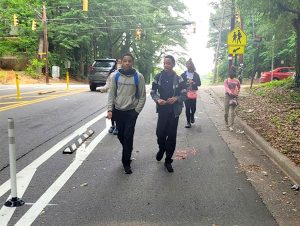We at the National Center for Safe Routes to School believe in the importance and joy of safe walking, biking and rolling. We know that active travel is the only way that some children and youth can get to school and that in many places the environment for walking and biking is not adequate. We have seen how events, such as Walk & Roll to School Day or Bike & Roll to School Day, can bring elected officials and community members together to commit to addressing urgent safety needs or simply to reinforce the value of choosing to walk or ride. At the National Center, we coordinate Walk & Roll to School Day and Bike & Roll to School Day in the U.S. to help communities create the momentum needed for lasting change. We then go further to create resources and strategies to support lasting change. Our work uses research-based evidence to highlight what works and why, and we translate this research into tools to provide communities with the principles and strategies they need to make community-enhancing decisions.
Walk & Roll to School Day and Bike & Roll to School Day
 The National Center is the coordinating organization for Walk & Roll to School Day held every October and Bike & Roll to School Day held each May. These events are used to encourage families to celebrate the benefits of walking and rolling and to increase local leader commitment and visibility for traffic safety and community quality of life. Most event coordinators report that their events led to changes to policies or the physical environment—the kinds of changes needed to support safe walking and rolling every day, not just for special events. Visit the Walk, Bike & Roll to School website to learn more, register an event, or see schools that are already participating.
The National Center is the coordinating organization for Walk & Roll to School Day held every October and Bike & Roll to School Day held each May. These events are used to encourage families to celebrate the benefits of walking and rolling and to increase local leader commitment and visibility for traffic safety and community quality of life. Most event coordinators report that their events led to changes to policies or the physical environment—the kinds of changes needed to support safe walking and rolling every day, not just for special events. Visit the Walk, Bike & Roll to School website to learn more, register an event, or see schools that are already participating.
Vision Zero for Youth
 In 2015, the National Center saw how Safe Routes to School could inform communities’ Vision Zero efforts. We launched the Vision Zero for Youth initiative, which builds on how cities and communities across the U.S. are taking a bold lead in setting ambitious goals to eliminate traffic fatalities and serious injuries and calling it Vision Zero. A growing group of these cities focus on improving safe walking and bicycling in school zones and other places where youth are present. Starting with youth also can be the spark that creates community support for a broader Vision Zero program.
In 2015, the National Center saw how Safe Routes to School could inform communities’ Vision Zero efforts. We launched the Vision Zero for Youth initiative, which builds on how cities and communities across the U.S. are taking a bold lead in setting ambitious goals to eliminate traffic fatalities and serious injuries and calling it Vision Zero. A growing group of these cities focus on improving safe walking and bicycling in school zones and other places where youth are present. Starting with youth also can be the spark that creates community support for a broader Vision Zero program.
The Vision Zero for Youth initiative encourages communities and their elected officials to focus safety improvements and efforts to slow traffic speeds where children and youth travel. Find out more about Vision Zero for Youth and read about cities the National Center has recognized for taking bold action to make streets safer for its young people.

Atlanta, GA. Source: City of Atlanta
Quick-build Projects
The National Center for Safe Routes to School is in its third year of a pilot program to support low-cost, quick-build infrastructure improvements to support safe, active travel for youth in underserved neighborhoods. We’ve partnered with the following places: city of Atlanta, GA; city of Cincinnati, OH; Pueblo of Jemez, NM; town of Winterville, NC; city of Detroit, MI; town of Red Bank, NJ; Macon-Bibb County; city of Akron, OH; and city of Milwaukee, WI. Made possible by General Motors, these small grants of approximately $10,000 each have been leveraged to make real impacts in advancing safe walking and biking.
Safe Routes to School
Safe Routes to School programs aim to make it safer for students to walk and bike to school and encourage more walking and biking where safety is not a barrier. Community members; public health, planning and transportation professionals; and school communities all have roles to play to change norms in how we move around our communities and make it appealing and safe for students to walk, bike or roll to school.
Research and Evaluation
In 2006, the National Center developed a centralized data collection and reporting system to understand and evaluate the uptake of the Federal SRTS Program and look for changes in walking and bicycling participation. Until mid-2024, the National Center provided free data processing services to local and State SRTS programs and data sharing for research purposes. The system generated summary reports to make it easy to share findings with community partners, decision makers and others interested in understanding walking and biking rates for students. Capturing millions of school travel trips, these services made local, state and national assessment, evaluation and research possible.
The travel patterns reported in 2016 by the National Center’s study of 720,000 parent surveys from 6,500 schools show a promising upward trend: walking to and from school increased from less than 14 percent to more than 17 percent of all school trips between 2007-08 and 2014. The National Center examined the role of child safety and Vision Zero programs in six US cities and conducted a two-year Vision Zero for Youth Demonstration Project in Philadelphia, PA from 2019-2021 and identified Nine Strategies Cities Use to Promote Safe, Active Travel for Children and Youth in 2024 based on interviews with six cities that received the Vision Zero for Youth US Leadership Award
Tools and Training
As part of support for the Federal SRTS Program, the National Center developed a menu of online and in-person training and technical assistance options with the purposes of building consensus, identifying issues and solutions, supporting equity and prioritizing needs. The National Center trained more than 262 instructors who taught the SRTS National Course across the country with the goal of bringing stakeholders together and providing quality information and tools to use to make decisions about the future of their communities. A peer exchange program enabled state leaders to connect with others with similar issues or solutions. A tool developed with the Institute of Transportation Engineers enabled communities to prioritize locations for safety infrastructure improvements. This tool was updated to use systemic safety analysis.
The National Center for Safe Routes to School is part of the UNC Highway Safety Research Center (HSRC), established in 1965. We work closely with the Pedestrian and Bicycle Information Center (PBIC), which is also part of HSRC and serves as the US Department of Transportation’s clearinghouse for pedestrian and bicycle research and tools. The National Center was established in 2006 when HSRC was selected to serve as the Federal Highway Administration’s Safe Routes to School Clearinghouse. The Safe Routes to School National Course, developed by the Pedestrian and Bicycle Information Center and later maintained by the National Center, was funded by the Centers for Disease Control and Prevention, the Environmental Protection Agency, Federal Highway Administration, and the National Highway Traffic Safety Administration. The National Center is applying what we have learned during our ten years of serving as the clearinghouse as we broaden our initiatives including Vision Zero for Youth and quick-build projects. Our Vision Zero for Youth initiative was launched with support from the FIA Foundation and the US Department of Transportation in 2016. Quick-build projects and other initiatives have been made possible with funding from General Motors starting in 2022.
Our SRTS funders have included the Federal Highway Administration, the National Highway Traffic Safety Administration, General Motors, Schwinn, Clorox Greenworks, and the Robert Wood Johnson Foundation.